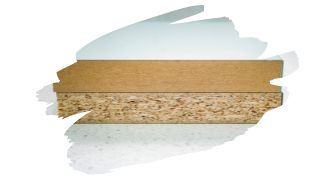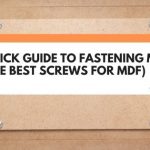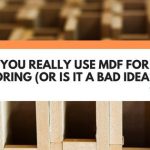As a woodworking enthusiast, you already know by now that polyurethane is a fantastic water-resistant wood sealer.
Most other wood finishes are more water-repellent coatings than water tight sealants. And when it comes to MDF, water proofing this material is very important.
But, MDF (Medium Density Fiberboard) is a tricky material to properly seal.
The very nature of this water-wicking engineered wood means that humidity and moisture can easily cause it to warp. So, it’ll need a quality water-resistant sealant to protect it from water-damage.
But, is polyurethane really up to the job?
Well, in this post, you will learn why only solvent-based wood sealers should be used on MDF. You will also discover the difference between the three main types of polyurethane sealants — and why this matters when it comes to MDF.

This post may contain affiliate links to products that we receive a commission for (at no additional cost to you). Learn more here.
Do You Really Need To Seal MDF?
Well, first off, MDF is a manufactured wood made up of compressed wood fibers. And the texture of this material makes it incredibly good at wicking up water.
As a result, MDF is easily water damaged — which is why it is rarely used for exterior construction.
However, even when used for interior pieces, MDF will still need to be sealed to prevent it from wicking up moisture. And those exposed MDF edges are particularly tricky to wholly seal.
So, yes, you will need to seal MDF with a water-resistant finish.
Related Post: Can You Really Use MDF Outside? (Best Practice Revealed!)
And What Happens To MDF If It Gets Wet?
If you don’t seal MDF it will swell up as it absorbs moisture.
And, because of the nature of this material, it takes forever to dry out afterward. So, you’ll end up with MDF bowing out of shape.
Related Post: Why Is My MDF Board Warping? (+ How You Can Fix It)
Now, the only MDF that’s resistant to bowing, is exterior-grade MDF. But, full disclosure, this particular type of Medium Density Fiberboard material isn’t completely waterproof.
Nevertheless, it is much more moisture-resistant than you everyday standard MDF board.
What Kinds Of Wood Finishes Are Suitable For Sealing MDF?
Stick to using solvent-based finishes, and avoid using any kind of water-based finish.
If you use water-based products on MDF, it’ll soak up the water-content (in those products) much too quickly. This then leads to adhesion problems, as the finish hasn’t had time to properly set and cure.
In fact, this is a particular issue when it comes to using water-based glues on MDF.
Related Post: A Quick Guide To Fastening MDF (+ The Best Screws For MDF)
So This Means An Oil Finish (Like Boiled Linseed Oil) Is Good For MDF?
Not quite. The problem with coating MDF with oil finishes, like Linseed or Tung oil, is that they aren’t that water-resistant. They are — at best — water-repellent finishes. And these types of penetrating oil finishes can become water-damaged due to water spills.
A major reason for this is the fact that oil finishes are what are called microporous finishes. A microporous finish can prevent water droplets from getting past it. However, water vapor (i.e. high humidity) can still seep through it.
What About Polyurethane? Can You Use It To Seal MDF?
Absolutely you can. Polyurethane can truly seal the surface of wood, blocking humidity from damaging the material underneath.
This is all thanks to the urethane ingredient in these particulars sealers.
Urethane helps polyurethane to form a durable film made up of tightly bonded resin molecules. This, in turn, seals the surface of MDF in a plastic-like coat (once it has dried and cured).
What’s more, polyurethane also has a bit of ‘give’ to it, allowing it to absorb impacts and prevent scratching.
But, there is one caveat to all of this…make sure you use an oil-based polyurethane finish on MDF.
Why? What Types Of Polyurethane Are There?
There are three general types of polyurethane wood finishes that you can purchase;
- Oil-Based Polyurethane Sealers: These solvent-based finishes will leave behind the most natural looking finish.
Often, polyurethane can make wood look like it has been vacuum sealed in Saran-wrap. But, a clear oil-based polyurethane product won’t take away from the texture of natural wood.
This type of polyurethane product also looks great on MDF surfaces too. And because it is solvent-based, you won’t run into adhesion issues due to MDF’s fast water absorption.
- Water-Based Polyurethane: These water-based finishes will dry the fastest out of the three types of poly.
The water in this finish is the key to the quick-drying advantage of this polyurethane. Nonetheless, it’s also the reason why it isn’t suitable for sealing MDF.
Plus, water-based polyurethane finishes tend to look a touch more ‘plastic’ than oil-based poly’s.
- Water-Based Oil-Modified: These polyurethane finishes can give you the best of both worlds.
Water-based oil-modified polyurethane products dry faster than oil-based ones. And they have lower VOC levels than oil-based polyurethane too.
VOC’s (Volatile Organic Compounds) are those incredibly strong fumes that come off of oil-based finishes.
These modified polyurethane finishes also have an amber appearance that look more natural than water-based poly coats. But, despite their oil-modifier, these poly’s can still run into adhesion issues on MDF.
To Wrap Up, Here Are The 3 Key Takeaways From This Post…
- 1). MDF is a notoriously water-wicking manufactured wood. It absorbs moisture so easily that even water-based finishes and glues can struggle to adhere to it.
- 2). MDF will need some kind of water-resistant wood finish to protect it from water-damage.
- 3). Only use solvent-based finishes, such as oil-based polyurethane, on MDF.
References:
Yang, Han-Seung, et al. “Water absorption behavior and mechanical properties of lignocellulosic filler–polyolefin bio-composites.” Composite structures 72.4 (2006): 429-437.



